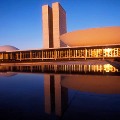
A (very brief) Guide to Brasilia
The basic structure of Brasilia was completed in just four years, from 1956 to 1960, under the leadership of President Juscelino Kubitschek, with the slogan “fifty years of progress in five”, and the city is in a sense a memorial to him.
In less than four years, this place went from an idea to Brazil’s living and breathing capital city. Thought up by urban planner Lucio Costa in 1957, with buildings designed by architect Oscar Niemeyer, the city was laid out as a cross, but better resembles a butterfly or airplane shape when seen from the air. While some have criticized the design, it was declared a UNESCO World Heritage site.
Predominant Architecture:
Modernist in style, the design was inspired by Le Corbusier, a French architect considered a forefather of modern architecture.
Places to See:
Palacio da Alvarado: The official residence of the president of Brazil. Its arches are icons of the capital.
Juscelino Kubitschek Memorial: on the western part of the axis is a museum dedicated to the life and accomplishments of the president. It’s located underground and has a slightly spooky 1960’s science-fiction feel to it.
Cathedral Basilica: is midway along the axis. With its sixteen curved 90-ton concrete pillars and stained-glass panels, is one of the world’s most amazing modernist buildings.
Three Powers Square: At the extreme end of the axis includes the seats of the country’s 3 highest authorities: the Congress, the Presidential Palace, and the Supreme Court.